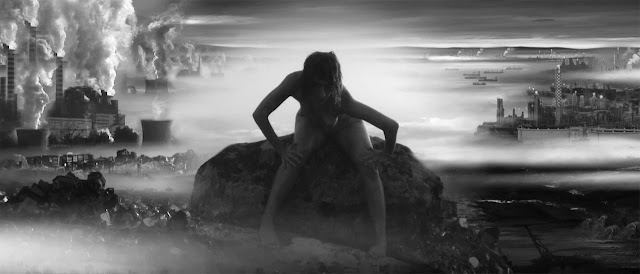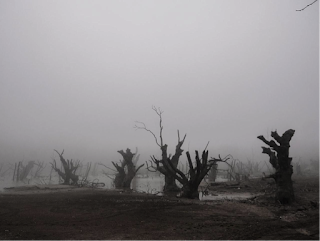"The radical edge": art's agency in ecological disasters
“From the 1960s through most of the
1990s, the Left considered environmentalism to be ‘soft politics’. While the
bold action of Greenpeace and the extremes of 'eco-terrorism’ had to be
acknowledged, for the most part those who supposedly cared more for the earth
and its creatures/creations than for people's revolutions were perceived as
acting from a kind of political suburbia. Today, sparked by indisputable proof
of human agency in climate change, the environment is in the centre foreground.
It has become the radical edge.”
Lucy R. Lippard, “Beyond the Beauty
Strip”
 |
| Vassilis P. Karouk, "Prima Materia", 2016, HD video (work commissioned by curator Nadja Argyropoulou for PCAI) |
Lippard’s poignant approach was prevalent in a three-week experiment, envisioned as a “festival” and organized in Delhi, India in 2008, and expanded via a blog and several contributions. Curator Pooja Sood, and her team attempted to “interrogate the teetering ecology of the city through the prism of contemporary art”. This eco-urban laboratory of 2008 has been just one of numerous fascinating examples of the ecology-art entanglement. There is a rich background and related bibliography as to the transition from the eco-aesthetics of the 60’s and 70’s [Land Art, Eco Art, Earth Works, the art of pioneers such as Robert Smithson, György Keppes and Gustav Metzger] to the political ecology of the ‘90’s and 2000s where artists have investigated the nature-culture complex and matters of sustainability, social justice and economic growth. In the recent end of such a rich genealogy, art seems to have deepened and widened its approach like never before, with the input of anthropology, social theory, queer studies, science, pedagogy and activism and in order to address the broader sociocultural disasters. In this respect “environmental art” as a niche cultural category, is being now considered obsolete. Texts, theoretical interventions, exhibitions of various formats and worldwide art curatorials emerge as acutely aware of environmental developments; they re-imagine possible solutions and provide important links with political formations, economic theories and other major humanitarian crises (such as the refugee crisis and the wave of displacements it produces).
Felix Guattari’s concept of “ecosophy”
– the three related ecologies of environmental, mental and social worlds and
their mix into a life-changing practice – has been re-introduced via its
readings by the arts and enriched by the experiences of 21st century
life.
This blog has already made note of the
important work developed by cultural/political theorists, such as T.J.Demos, via
writing, teaching and curating.
 |
| Eva Papamargariti "Always a body, always a thing” , still from single-channel video, sound, color, courtesy of the artist, 2016-2017 work commissioned by curator Nadja Argyropoulou for PCAI |
Dynamic platforms such as World of Matter, devise a new kind of
ecological knowledge commons while artists -founding members like Ursula Biemann travel
the planet and investigate environmental catastrophe in a way that is both
poetic and acutely political.
In big art Institutions around the
world - such as Documenta13 and Documenta14
or the Serpentine Gallery Marathons among many others, the expression of indigenous
peoples meets with queer practices, with the struggles for economic equality
and socially minded art works, thus producing new ecologies of co-existence or
“sympoeisis”.
In my native Greece, one of the countries
of the so-called “art periphery” and vis-à-vis neoliberal narratives of
‘growth’ and ‘development’ and the failure of the governance of the Left, the project/exhibition
“Paratoxic
Paradoxes”, recently curated by Nadja Argyropoulou, has commissioned international
artists to reflect on present toxic realities and wasteful politics with the
aim to shift attention to the extractivist dystopia clouding the future of all
crisis-ridden countries.
Artist Angela Melitopoulos’s image works
have repeatedly engaged with the perils of extractivism, either investigating
the gold-mining industry in Greece or
the passing between states of time and place as evidenced in the refugee camps.
 |
|
Excerpt
from the video ‘Unearthing Disaster - Corridor X - Postscript to an Unfinished
Journey - SOS Halkidiki’ (2:41)
|
It is true that environmentally engaged
art AND art oriented environmentalism can equally generate a wide web of events
ranging from revolutionary interventions to
spectacular gestures; In a
stunning performance, Greenpeace coordinated with Ludovico Einaudi to play
the piano in a remote region of the Arctic, currently one of the most fragile and threatened ecosystems on Earth.
There are arguments and
counter-arguments to be raised pro and against each and every case. Yet the
most important thing is to keep in mind that art can suggest unpredicted ways
to rethink the politics of ecology; it can expose nature’s tight binds with
culture, technology, economy; it can imagine “the radical edge” into
existence.


Hey Chris! It's so cool that ecological issues have been so unconventionally linked to politics (e.g. distopian worlds), culture (e.g. indigenous peoples and the LGBT community) and literature through so many varied mediums!
ReplyDeleteMy question is, do you think that the people most likely to be receptive of this niche portrayal of ecological issues are the people who already care? Does environmental art preach to a choir, or do you think it's message is accessible to and powerful over those who see climate issues as a distant threat, or see themselves as separate from nature?
Thank you Mari! I think this is a question everyone - even mildly contending with environmentalism- has asked themselves. How do we engage the general public and how do we make sure that these ways of engagement are not too 'niche' or 'elitist'.
DeleteI strongly believe in the power of art to influence and shape cultural narratives (aka the way we think and consequently act). I agree that only people already conscious of environmentalism would google a very specific ecology-themed exhibition and attend it, but as I've illustrated in this text, ecology is taking a central place in art. The environmental fight is increasingly integrated in other forms of struggle (fights for women's rights, LGBT rights, indigenous rights and so on) and people are starting to pay attention. And yes, art is helping disseminate this!